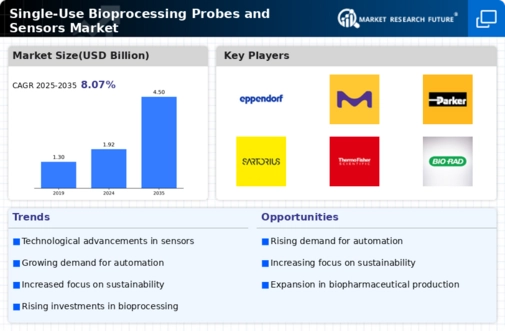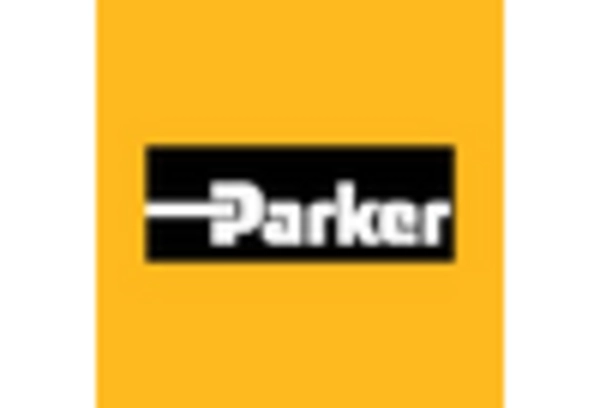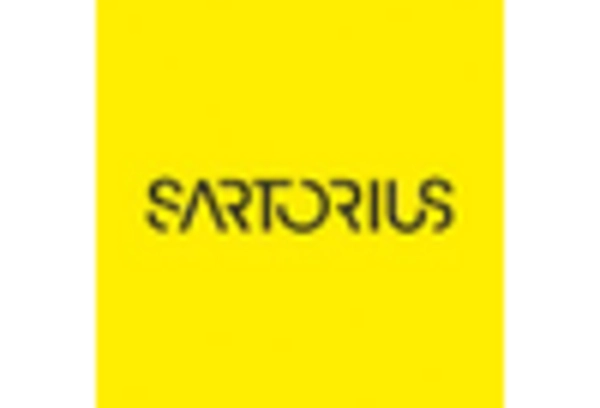Rising Demand for Biopharmaceuticals
The increasing demand for biopharmaceuticals is a primary driver for the Single-Use Bioprocessing Probes and Sensors Market. As the biopharmaceutical sector expands, the need for efficient and reliable bioprocessing technologies becomes paramount. The market for biopharmaceuticals is projected to reach over 400 billion USD by 2025, necessitating advanced monitoring solutions. Single-use probes and sensors facilitate real-time monitoring and control of bioprocesses, ensuring product quality and compliance with regulatory standards. This trend indicates a shift towards more flexible manufacturing processes, where single-use technologies play a crucial role in meeting the growing production demands. Consequently, the Single-Use Bioprocessing Probes and Sensors Market is likely to experience substantial growth as biopharmaceutical companies seek to enhance their operational efficiency.
Growing Focus on Personalized Medicine
The growing focus on personalized medicine is emerging as a key driver for the Single-Use Bioprocessing Probes and Sensors Market. As the healthcare landscape evolves towards more tailored treatment options, biopharmaceutical companies are required to develop therapies that meet specific patient needs. This shift necessitates flexible and scalable manufacturing processes, where single-use technologies can play a pivotal role. The ability to quickly adapt production lines to accommodate different therapies is crucial in this context. Single-use probes and sensors enable rapid process changes and facilitate the development of personalized therapies. As the demand for personalized medicine continues to rise, the Single-Use Bioprocessing Probes and Sensors Market is likely to benefit from this trend, reflecting the need for innovative bioprocessing solutions.
Regulatory Compliance and Quality Assurance
Regulatory compliance and quality assurance are vital drivers for the Single-Use Bioprocessing Probes and Sensors Market. The biopharmaceutical sector is subject to stringent regulations to ensure product safety and efficacy. Single-use probes and sensors provide a means to maintain compliance with these regulations by offering reliable and consistent monitoring of bioprocess parameters. The need for quality assurance in biomanufacturing processes has led to an increased focus on technologies that can provide accurate and reproducible data. As regulatory bodies continue to emphasize the importance of process validation and control, the demand for single-use technologies that facilitate compliance is expected to rise. This trend suggests that the Single-Use Bioprocessing Probes and Sensors Market will continue to expand as companies prioritize regulatory adherence and product quality.
Cost-Effectiveness of Single-Use Technologies
The cost-effectiveness of single-use technologies is a significant driver for the Single-Use Bioprocessing Probes and Sensors Market. Single-use systems reduce the need for extensive cleaning and sterilization processes, which can be time-consuming and costly. By minimizing downtime and operational costs, these technologies offer a more economical solution for biopharmaceutical manufacturers. The overall reduction in capital investment associated with single-use systems further enhances their appeal. As companies seek to optimize their production processes and reduce costs, the adoption of single-use probes and sensors is likely to increase. This trend indicates a shift towards more efficient manufacturing practices, positioning the Single-Use Bioprocessing Probes and Sensors Market for continued growth as cost considerations become increasingly important.
Technological Advancements in Sensor Technologies
Technological advancements in sensor technologies are significantly influencing the Single-Use Bioprocessing Probes and Sensors Market. Innovations in sensor design, such as miniaturization and enhanced sensitivity, are enabling more precise measurements in bioprocessing applications. These advancements allow for better monitoring of critical parameters, such as pH, temperature, and dissolved oxygen levels, which are essential for optimal cell culture and fermentation processes. The integration of smart sensors with IoT capabilities is also emerging, providing real-time data analytics and remote monitoring. This evolution in sensor technology not only improves process efficiency but also reduces the risk of contamination, a critical concern in biopharmaceutical manufacturing. As a result, the Single-Use Bioprocessing Probes and Sensors Market is poised for growth driven by these technological innovations.


















Leave a Comment